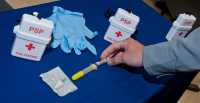
15 Nov More Pharmacies Willing To Dispense Naloxone Without Prescription
MedicalResearch.com Interview with:
Kirk Evoy, PharmD, BCACP, BC-ADM, CTTS
 Clinical Assistant Professor
Clinical Assistant Professor
College of Pharmacy, The University of Texas at Austin
Adjoint Assistant Professor
School of Medicine, University of Texas Health Science Center at San Antonio
Ambulatory Care Pharmacist
Southeast Clinic, University Health System
UT Health Science Center at San Antonio
Pharmacotherapy Education and Research Center
San Antonio, TX 78229
MedicalResearch.com: What is the background for this study? What are the main findings?
Response: Previous studies in Indiana and New York City, and the similar study in California published alongside ours identified that, despite the fact that laws designed to increase naloxone access had been in place for 2-3 years, patients were still not able to obtain naloxone without first seeing a doctor in many pharmacies.
Our study showed contrasting results to the previous studies, with a much higher proportion of pharmacies stocking naloxone and stating their willingness to dispense without an outside prescription. Among the 2,317 Texas chain community pharmacies we contacted, 83.7% correctly informed our interviewers that they could obtain naloxone without having to get a prescription from their doctor before coming to the pharmacy. We also found that 76.4% of the pharmacies had at least one type of naloxone currently in stock.
MedicalResearch.com: What should readers take away from your report?
Response: New legislation does not always produce the anticipated outcomes after it is passed or adoption of new laws may be slow in some cases. This study is important to patients and health care providers because it provides insight into whether or not these laws being passed to increase availability of naloxone are actually having the anticipated real-world impact. And given that the results of this study did show that a greater proportion of pharmacists surveyed were willing to dispense naloxone and more had it in stock than previous similar studies have shown,
I think this study provides some evidence that the accessibility of naloxone from a pharmacy without an outside prescription is growing. However, it also sheds light on the fact that there is still significant room for improvement with regards to making this potentially life-saving medication available to patients who need it.
So, I view the results of this study as an indication that positive steps forward are being made with regards to increasing naloxone availability (and hopefully, in turn, reducing the number of fatal opioid overdoses), but also as a call to action for community pharmacies to continue to educate their pharmacists and support staff regarding naloxone access laws and company policies regarding naloxone dispensing.
MedicalResearch.com: What recommendations do you have for future research as a result of this work?
Response: I think next steps include systematically assessing what the barriers are that keep pharmacists from dispensing naloxone without an outside prescription, despite their ability to do so, as well as identifying ways to overcome these barriers. Our group has follow-up studies ongoing to help address these issues.
MedicalResearch.com: Is there anything else you would like to add?
Response: Dr. Evoy reports that he has received grant funding from The University of Texas Health San Antonio Institute for Integration of Medicine and Science, the Kleberg Foundation, and Texas Health and Human Services to conduct opioid overdose prevention and response training, which includes providing education on the proper use of naloxone and distribution of naloxone within the community. All formulations of naloxone are discussed in these trainings. The trainings conducted are solely for the purposes of reducing opioid overdose harm in the community.
Dr. Hill reports previously receiving donations of branded formulations of naloxone from Kaléo Pharma and Adapt Pharma for community distribution, in support of efforts to reduce opioid overdose harm in the community. He received a donation of EVZIO Auto-Injectors from Kaléo Pharma immediately following Hurricane Harvey for distribution to people who use illicit opioids, whose risk for accidental overdose was increased by a destabilized supply chain. He also received a donation of NARCAN Nasal Spray from Adapt Pharma to distribute on campus in support of overdose preparedness efforts at The University of Texas at Austin.
The other authors of this study have no conflicts of interest to disclose.
No funding was obtained to complete this study.
Acknowledgements: We would like to acknowledge the following people who assisted with data collection: Ashley Dinh, Judy Chan, Ravi Gandhi, My Tran, Ashly Daioub, Alyeshka L Jusino-Acosta, Rubya Khalid, Will Godinez, Kallie Erickson, Jillian Contreras, Judith Rendon, Brian Olivares, Suman Augsteen, Kimberly Nguyen, Brian Jermain, Uzma Ahmed, Sophie Tabe, Any Jivan, Michelle Tran, Melissa Evens, Ryan Ung, Baneen Noorali, Ryan Izadi, Mandy Renfro, Jennifer Ngoc La, Maddie Burgess, Sajidah Marwat-Khan, Noor Atiyah, Sara Smith, Eli Aggor, Shelby Humpert, Sarvnaz Sadrameli, Hannah Mucha, Nishat Huq, Shelly Goyal, Miriam Easo, Randi Braak, Itzel Alfaro-Rivas, Ashley Abraham, Samantha Le, Emma Gugala, Lindsey Loera, Jonathan Patterson, Ashley Sotoodeh, Sarah Piccuirro, Alexis Alba, Karen Aymá, Chenyuan Zhou, Hannah Spencer, James Hsu, Jessica Arianna Galindo, Kayla Kotara, Cameron Roy, Mariela Silva, David Giang, Kenny Nguyen, and Yi Kee Poon. They were not compensated for this role.
Citation:
Evoy KE, Hill LG, Groff L, Mazin L, Carlson CC, Reveles KR. Naloxone Accessibility Without a Prescriber Encounter Under Standing Orders at Community Pharmacy Chains in Texas. JAMA. 2018;320(18):1934–1937. doi:10.1001/jama.2018.15892
[wysija_form id=”3″]
[last-modified]
The information on MedicalResearch.com is provided for educational purposes only, and is in no way intended to diagnose, cure, or treat any medical or other condition. Always seek the advice of your physician or other qualified health and ask your doctor any questions you may have regarding a medical condition. In addition to all other limitations and disclaimers in this agreement, service provider and its third party providers disclaim any liability or loss in connection with the content provided on this website.
Last Updated on November 15, 2018 by Marie Benz MD FAAD
